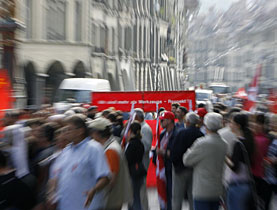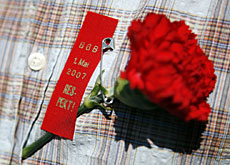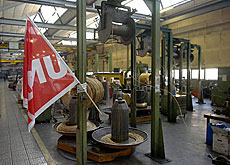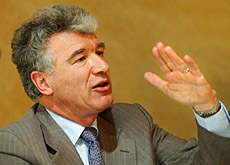May 1 tracks the pulse of class struggle

Since it was first introduced in 1890, Labour Day has always been a barometer of workers' demands and class struggles in Switzerland.
A new book by historian Urs Anderegg, “Der 1. Mai in der Schweiz – der Traum einer besseren Welt” (May 1 in Switzerland – the dream of a better world), looks back at the evolution of this special day in the working year.
swissinfo: How did May 1 evolve?
Urs Anderegg: Right from its very beginning Labour Day crystallised workers’ desire to find cohesion and fulfil their aspirations. At the time, the [centre-left] Social Democratic Party was still new and unions were only being thought about. Workers responded to the second Socialist International’s call for a Labour Day [in 1889], but May 1 was celebrated in different ways depending on the canton, the town or even the factory.
swissinfo: What was the reaction of the middle classes?
U.A.: Contrary to what happened in other European countries such as Germany or France where the police intervened, Labour Day was relatively well received in Switzerland. At first the bourgeoisie was somewhat concerned, and some workers were fired for downing tools on May 1. But any fears quickly vanished after people saw that events stayed peaceful. In the first few years the demonstrations were considered to be like carnival or guild parades.
swissinfo: But the class struggle became much more radical in the early 20th century.
U.A.: This trend was expressed in the Marxist programme adopted by the Social Democrats in 1904. The number of people joining the party and unions also rose significantly. The working class came to realise its strength, a fact that became obvious on Labour Day. The parades changed into political rallies.
Initially workers would walk from the city to the countryside where festivities usually took place. But from the beginning of the 20th century the march left the outskirts to head for the town centre. In Zurich for example the march took workers to the Bahnhofstrasse, the city’s economic heart. It was obvious that a political change had taken place. The carnival or guild elements also disappeared in favour of banners and other symbols of the political Left.
swissinfo: Did this awakening of workers’ political awareness peak with the 1918 general strike?
U.A.: The Russian Revolution and the hardships created by the First World War had helped forge a tense political climate. It was no surprise that the army was ready to intervene on May 1, 1918. But the failure of the general strike also led to disillusions among the Left. It was from this point on that Labour Day began to lose some of its importance, especially in rural areas, and has since been confined to the cities.
swissinfo: So did the class struggle give way to consensus politics in Switzerland?
U.A.: The Left continued to use revolutionary slogans for example during the Labour Day rallies. But the situation quietened down in the 1920s, when consensus building and work agreements between the working class and bosses became the norm.
These policies were strengthened in the 1930s by the arrival of Mussolini in Italy and Hitler in Germany: the twin threats of fascism and war reinforced national cohesion and identity. It was no surprise that Swiss flags were part of Labour Day rallies in 1938. The threats also reinforced the Left’s democratic values, moving it further away from the Marxist class struggle.
swissinfo: Why is it that Swiss workers weren’t as combative as their colleagues in other European countries after the Second World War?
U.A.: After the war political stability and economic prosperity probably helped undercut any desire to start a class struggle all over again. It was obvious during the May 1 rallies. The will to demonstrate and make demands slowly weakened after 1945. Demonstrations changed into a procession for civil servants and workers, usually older ones. The political spirit was revived mainly by foreign workers and leftwing movements that appeared after 1968 such as the pacifists and the anti-nuclear lobby.
swissinfo: What do the Labour Day demonstrations mean today?
U.A.: In Switzerland they are a sort of ritual that allows leftwing militants and their friends to meet and reaffirm certain values. For the unions it represents a more conservative approach since they tend to defend earlier gains made by workers. May 1 is also important for political groups not represented in parliament and foreigners’ associations who don’t have other opportunities to make themselves heard.
swissinfo-interview: Armando Mombelli
In 1889 the second Socialist International decided that May 1 would be Labour Day. The following year millions of workers answered the call across Europe, including in Switzerland.
Switzerland is one of the few countries where Labour Day has been celebrated continuously since its inception.
The biggest Swiss demonstration was held in Zurich in 1919, with 50,000 people taking part.
Today 10,000-20,000 people take part in the rallies held across the country. In the past few years violent incidents led by autonomist groups have rocked the demonstration in Zurich.
May 1 is an official public holiday in ten of Switzerland’s 26 cantons.

In compliance with the JTI standards
More: SWI swissinfo.ch certified by the Journalism Trust Initiative




You can find an overview of ongoing debates with our journalists here. Please join us!
If you want to start a conversation about a topic raised in this article or want to report factual errors, email us at english@swissinfo.ch.